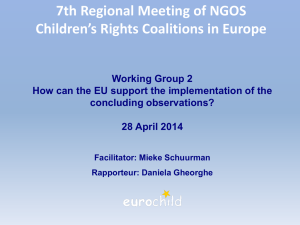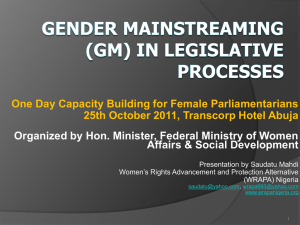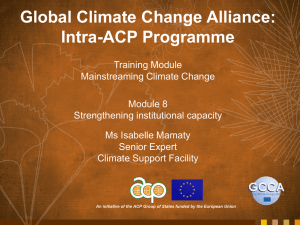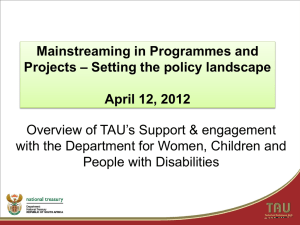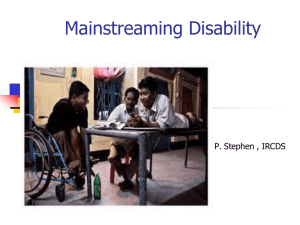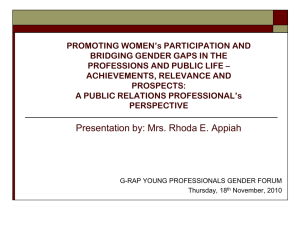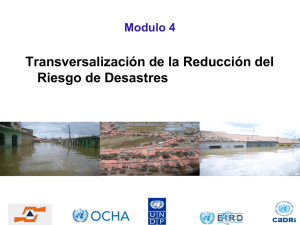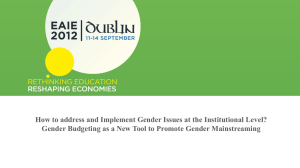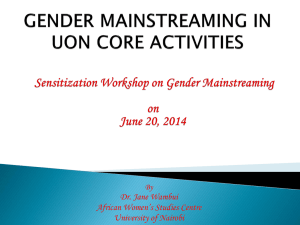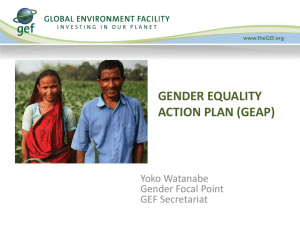Module 3 - Why Mainstreaming - Global Climate Change Alliance
advertisement
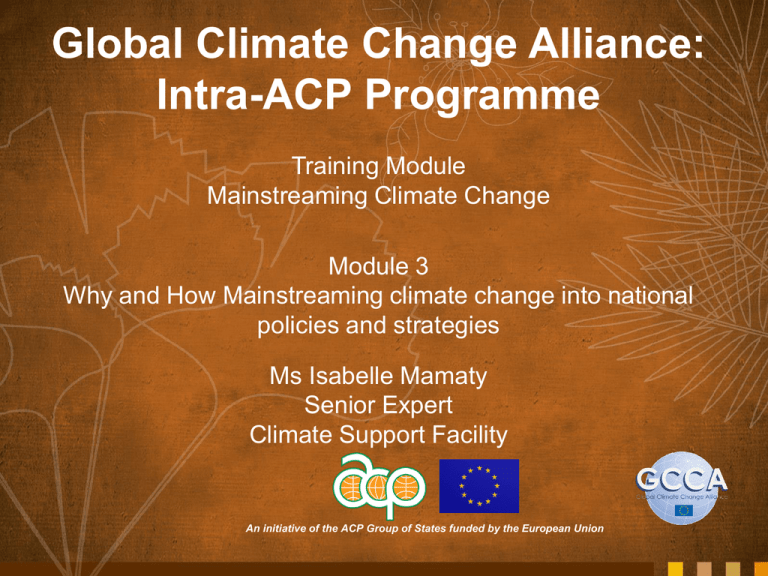
Global Climate Change Alliance: Intra-ACP Programme Training Module Mainstreaming Climate Change Module 3 Why and How Mainstreaming climate change into national policies and strategies Ms Isabelle Mamaty Senior Expert Climate Support Facility An initiative of the ACP Group of States funded by the European Union Why and how Mainstreaming CC into national policies and strategies Learning objectives: o To understand why it is important to mainstream climate change (CC) into development planning o To understand the different steps of the mainstreaming of CC into development planning Expected outcomes: o Increased knowledge on mainstreaming steps o Increased knowledge on mainstreaming tools 2 What is mainstreaming, and why mainstream climate change? 3 From project-based approaches... Project-based adaptation approaches such as those developed in NAPAs are a first step in the right direction: o Contribution to national capacity building o Involvement of stakeholders at grassroots level o Identified projects usually correspond to real priorities and involve wider developmental benefits But there are also problems, notably: o Poor institutional arrangements for implementation o Low capacity for adaptation planning and implementation Source: World Bank (2010a) WDR 2010 4 ... to climate change mainstreaming In the medium and long term, standalone projects are unlikely to meet all adaptation and mitigation requirements in a costeffective, scalable manner There is a strong case for mainstreaming climate change into all development planning, both at strategic planning levels and in local development 5 What is mainstreaming? The mainstream: the prevailing or dominant course, current, tendency or way of thinking Mainstreaming: the informed integration of a relevant value, theme or concern into the decisions of institutions that drive national, local and sectoral development policy, rules, plans, investment and action (adapted from Dalal-Clayton & Bass 2009) o Institutional strengthening and change and capacity building are at the heart of any mainstreaming effort Integrated and shared response to the complexity and challenges of sustainable development 6 Objectives of mainstreaming Mainstreaming is a long-term, iterative process aimed at: o transforming ideas o even more importantly, transforming policies, resource allocations and practices in order to: o promote desired developmental outcomes (with regard to gender, environment, climate change, governance, human rights, ...) o and support integrated solutions to human problems 7 Why mainstream climate change? Climate change is a potentially significant threat to on-going development / poverty reduction efforts Pursuing economic growth is necessary but not sufficient to respond to climate-related challenges Climate change impacts are complex and require coordination across multiple sectors Standalone responses to climate change may distort development priorities and foster maladaptation An adequate, strategically designed response can bring significant developmental benefits 8 Why mainstream climate change at strategic planning levels? (1) National level More: -integrated -effective -efficient -sustainable responses Sector 1 Sector coordination Biophysical impacts Sector 2 Allocation of resources across sectors Sector 3 9 Socioeconomic impacts Why mainstream climate change at strategic planning levels? (2) National level Sector level Overall guiding policy framework Operationalisation and implementation of national policies National legislation/regulation Sector-specific legislation/regulation Exercise of some key functions Own initiatives, development of capacities & good practices Management of international relations Transboundary cooperation on climate-relevant issues Wider pool of resources Wider ownership of response More widespread capacity and institution building 10 Source: OECD (2009a) Why mainstream climate change at lower levels of governance? Best levels for observing / understanding development and climate change impacts Vulnerability and adaptive capacity are contextspecific Sub-national and local levels Most adaptation options require local implementation Potential for piloting / pioneering initiatives 11 Source: OECD (2009a) How mainstreaming climate change ? 12 Finding the entry points and making the case Mainstreaming CC into policy and planning processes Preliminary assessments Mod1 Understanding the science Understanding CC– Mod2 development linkages Understanding climaterelated uncertainties Collecting country-specific evidence and influencing Mod3 policy processes Mainstreaming CC in (sub)national and sector Mod9 policies, strategies, programmes Raising awareness and Mod4 building partnerships National consensus and Mod10 commitment to climateresilient, low-emission development Strengthening institutions and capacities Needs assessment Mod8 Working mechanisms Costing, assessing and selecting adaptation and mitigation options and measures Mod5 Strengthening institutions and capacities Mod8 Learning by doing Meeting the implementation challenge Budgeting and financing Mainstreaming CC in the Mod6 budgetary process Mainstreaming CC in monitoring systems Performance assessment frameworks Mod7 Supporting policy measures National, sector and subnational levels Strengthening institutions and capacities Mod8 Mainstreaming as standard practice Engaging stakeholders and coordinating within the development community Adapted from: UNDP-UNEP (2009) Figure 3.1, p. 15 Main entry points in the national and sector policy cycles Recognise climate risks Allocate funding for climate-specific actions Policy formulation National long-term vision National policies and strategies Planning Multi-year development plan Include Sector level climate consideraSector policies and strategies tions in project selection Sectoral plans criteria Resource allocation National budget Climate-related fund(s) Sector budget envelopes Resources from fund(s) Programming & implementation Sector-level development plans and budgets Sector programming Policy cycle stage Include climaterelated programmes/ projects (sectoral and cross-sectoral) National level Relocate funding to vulnerable or priority sectors/ regions Incorporate climate-related activities Adapted from: Olhoff & Schaer (2010) Fig. 1, p. 10 Entry points for mainstreaming in the policy cycle Finding the entry points & making the case Mainstreaming CC into policy & planning processes Agenda setting National development planning Meeting the implementation challenge Policy making Implementation & monitoring 15 Adapted from: UNDP-UNEP (2009) Figure 3.2, p. 15 Key institutional requirements for effective mainstreaming Cross-sectoral & cross-level coordination, cooperation Powerful champions at national level Effective mainstreaming Experience sharing, dissemination of good practices Timely stakeholder participation at various scales e.g. office of prime minister, ministries of finance/budget/planning Integration of new thinking, new research in planning & monitoring systems & processes Strengthening of capacities of stakeholders at various scales Key institutional requirements for effective mainstreaming Availability and quality of : o Climate related information and evidence o climate information; o socio-economic analyses of key linkages between climate change and development o Institutional strengthening and capacity building o assessments of costs and benefits of climate change adaptation activities; o resources and commitment to support continuous capacity building and institutional strengthening o resources and technical capacity The level of engagement of a broad range of stakeholders at all levels; Existence of and possibility for technical support; A mix of ‘Top-down’ and ‘Bottom-up’ approaches. 17 Key stakeholders Ministries of Finance, Planning, Development Donor agencies Ministries with sector-specific competences Members of Parliament Sub-national / local governments Civil society organisations Research organisations Sector management agencies Local citizens & organisations Private sector Local private sector 18 Top-down and bottom-up approaches to adaptation National policies & strategies Adaptation Subnational levels (local in particular) Freely adapted from Dessai & Hulme (2004) 19 Bottom-up Focused on physical impacts and ‘biophysical vulnerability’ Stakeholder approach Top-down Model- and scenariodriven National level incl. sectors Focused on prevailing socio-economic & environmental conditions and on ‘social vulnerability’ Communitybased adaptation, pilot projects Roles & responsibilities of main stakeholders Stakeholder group Main roles & responsibilities Central government (incl. office of Leadership, performance management frameworks Policies, standards & regulations Allocation of budget resources Guidance & capacity building prime minister, ministries of finance/budget/planning, ...) Local governments Implementation of national policies Integration with community strategies Private sector Preparation for losses & opportunities, risk mngt Contribution to sustainable investments & vulnerability reduction through development Scientific & academic organisations Policy-oriented research Support for decision making Investment promotion agencies Climate-proofing of investments, bridging of development gaps Poverty reduction organisations Climate change adequately addressed Adapted from: Schipper et al (2008) Turning words into action 21 Discussion Questions and answers Mainstreaming climate change into national policies and strategies What are the opportunities to mainstreaming climate change in your sector or at your level and what are the institutional and capacity needs in your organisation to do so? 22 Presentation of case studies Presentation of case studies of strategic documents that have mainstreamed climate change identification of best practices in mainstreaming climate change 23 Learning process exercise: Working group Exercise: select a strategic national or sectoral document of the specific country and analyse how climate change has been integrated in this document 24 Recap – Key messages There is a strong case for mainstreaming climate change into all development planning There are entry points for mainstreaming climate change at all stages of the policy cycle Mainstreaming climate change at strategic planning levels supports more integrated, effective, efficient and sustainable responses o But top-down and bottom-up approaches to adaptation are complementary and mainstreaming is also justified at local level Evidence supports both the engagement of key actors and the development of a communication and advocacy strategy 25 Key references EC (2009a) EC Cooperation: Responding to Climate Change – ‘Sector scripts’ series. European Commission, Brussels EC (2009b) Guidelines on the Integration of Environment and Climate Change in Development Cooperation. European Commission, Brussels OECD (2012) : Integrating Climate change Adaptation into Development Co-operation, policy guidance, revised version UNDP (2011) Practitioner’s Guide: Capacity Development for Environmental Sustainability. United Nations Development Programme, New York UNDP-UNEP (2011) Mainstreaming Adaptation to Climate Change into Development Planning: A Guide for Practitioners. UNDP-UNEP PovertyEnvironment Initiative UNDP – Integrating environment into development: http://www.undp.org/mainstreaming/ 26 • Thank you • Contact: Dr. Pendo MARO, ACP Secretariat pendomaro@acp.int or +32 495 281 494 www.gcca.eu/intra-acp 27
